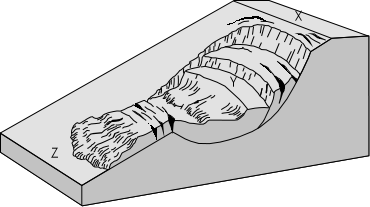- The web site at
http://landslides.usgs.gov/hazards/nationalmap/ shows the National Landslide Hazards Map, published by the U.S. Geological Survey.
This is a map of the lower 48 states showing areas where there have been a high
incidence of landslides, and areas that have a high susceptibility to landslides.
Notice that you can click on various dots on the map and map legend to get an
enlargement of
various areas or the legend of the map. On the large map, the areas colored in red
are areas where there is a high incidence of landslides (covering greater than 15% of the
area). There are three major zones where high incidence of landslides
occur. (1) near the west coast in the states of California,
Oregon, and Washington, (2) in the Rocky Mountain states of Colorado,
Utah, and Wyoming, and (3) in the Appalachian mountain states of Ohio,
Pennsylvania, Virginia, West Virginia, Kentucky, Tennessee, and Georgia. Surrounding
these areas are areas of high to moderate susceptibility to landslides.
- For each of these three areas that have high incidence or susceptibility to landslides,
what geologic features are present that contribute to the high incidence or susceptibility
to landslides? In answering this question, think about the major factors involved in
landslides (the role of gravity, especially slope angle, the role of water, the role of
different geological materials like soil and rock, and the presence of processes that
trigger landslides (see lecture notes on Slope
Stability if you need reminders about these factors).
BE VERY SPECIFIC FOR EACH OF THE 3 AREAS. (6 points)
- Find as near as possible the area where you live (when not attending
Tulane). What zone do you live in (answer by first stating exactly where you live,
then by indicating the color zone on the map and the meaning of the color zone from the
map legend)? If it is a zone with a moderate to high incidence of landslides or a
zone with a moderate to high susceptibility to landslides, what features in the area do
you think are responsible for the incidence or susceptibility rating? If it is zone
with a low incidence or low susceptibility of landslides, what features or lack of
features are responsible for the incidence or susceptibility rating? (2
points)
|
